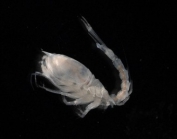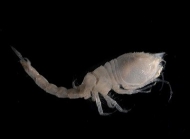Scheldt species taxon details
Diastylis bradyi Norman, 1879
110472 (urn:lsid:marinespecies.org:taxname:110472)
accepted
Species
marine, brackish, fresh, terrestrial
Norman, A. (1879). VI.—Crustacea Cumacea of the ‘Lightning,' ‘Porcupine,' and ‘Valorous' Expeditions. <em>Annals and Magazine of Natural History.</em> 3(13): 54-73., available online at https://doi.org/10.1080/00222937908682476
page(s): 59 [details]
page(s): 59 [details]
Watling, L.; Gerken, S. (2021). World Cumacea Database. Diastylis bradyi Norman, 1879. Accessed through: VLIZ Consortium Scheldt Species Register at: https://www.scheldemonitor.org/speciesregister/aphia.php?p=taxdetails&id=110472 on 2025-09-11
VLIZ Consortium. Scheldt Species Register. Diastylis bradyi Norman, 1879. Accessed at: https://www.scheldemonitor.be/speciesregister/aphia.php?p=taxdetails&id=110472 on 2025-09-11
Date
action
by
original description
Norman, A. (1879). VI.—Crustacea Cumacea of the ‘Lightning,' ‘Porcupine,' and ‘Valorous' Expeditions. <em>Annals and Magazine of Natural History.</em> 3(13): 54-73., available online at https://doi.org/10.1080/00222937908682476
page(s): 59 [details]
context source (Schelde) Janssen, C.R.; Ghekiere, A.; Verslycke, T.; Vincx, M.; Fockedey, N.; Rappé, K.; De Brabander, H.; Noppe, H.; Roose, P.; Monteyne, E.; Vethaak, D.; Mees, J.; Deneudt, K. (2007). Endocrine disruption in the Scheldt estuary distribution, exposure and effects (ENDIS-RISKS). <em>Final report. Belgian Science Policy: Brussels.</em> 106 pp. (look up in IMIS) [details]
context source (BeRMS 2020) Bio-environmental research group; Institute of Agricultural and Fisheries research (ILVO), Belgium; (2015): Macrobenthos monitoring in function of the Water Framework Directive in the period 2007-2009. [details]
basis of record Watling, L. (2001). Cumacea, <B><I>in</I></B>: Costello, M.J. <i>et al.</i> (Ed.) (2001). <i>European register of marine species: a check-list of the marine species in Europe and a bibliography of guides to their identification. Collection Patrimoines Naturels,</i> 50: pp. 308-310 (look up in IMIS) [details]
additional source Muller, Y. (2004). Faune et flore du littoral du Nord, du Pas-de-Calais et de la Belgique: inventaire. [Coastal fauna and flora of the Nord, Pas-de-Calais and Belgium: inventory]. <em>Commission Régionale de Biologie Région Nord Pas-de-Calais: France.</em> 307 pp., available online at http://www.vliz.be/imisdocs/publications/145561.pdf [details]
additional source Zimmer, C. (1933). Cumacea. <i>The fauna of the North Sea and Baltic</i>, 23(10.g4). Akademische Verlagsgesellschaft: Leipzig, Germany. 70-120 pp. (look up in IMIS) [details]
page(s): 59 [details]
context source (Schelde) Janssen, C.R.; Ghekiere, A.; Verslycke, T.; Vincx, M.; Fockedey, N.; Rappé, K.; De Brabander, H.; Noppe, H.; Roose, P.; Monteyne, E.; Vethaak, D.; Mees, J.; Deneudt, K. (2007). Endocrine disruption in the Scheldt estuary distribution, exposure and effects (ENDIS-RISKS). <em>Final report. Belgian Science Policy: Brussels.</em> 106 pp. (look up in IMIS) [details]
context source (BeRMS 2020) Bio-environmental research group; Institute of Agricultural and Fisheries research (ILVO), Belgium; (2015): Macrobenthos monitoring in function of the Water Framework Directive in the period 2007-2009. [details]
basis of record Watling, L. (2001). Cumacea, <B><I>in</I></B>: Costello, M.J. <i>et al.</i> (Ed.) (2001). <i>European register of marine species: a check-list of the marine species in Europe and a bibliography of guides to their identification. Collection Patrimoines Naturels,</i> 50: pp. 308-310 (look up in IMIS) [details]
additional source Muller, Y. (2004). Faune et flore du littoral du Nord, du Pas-de-Calais et de la Belgique: inventaire. [Coastal fauna and flora of the Nord, Pas-de-Calais and Belgium: inventory]. <em>Commission Régionale de Biologie Région Nord Pas-de-Calais: France.</em> 307 pp., available online at http://www.vliz.be/imisdocs/publications/145561.pdf [details]
additional source Zimmer, C. (1933). Cumacea. <i>The fauna of the North Sea and Baltic</i>, 23(10.g4). Akademische Verlagsgesellschaft: Leipzig, Germany. 70-120 pp. (look up in IMIS) [details]
 Present
Present  Inaccurate
Inaccurate  Introduced: alien
Introduced: alien  Containing type locality
Containing type locality


